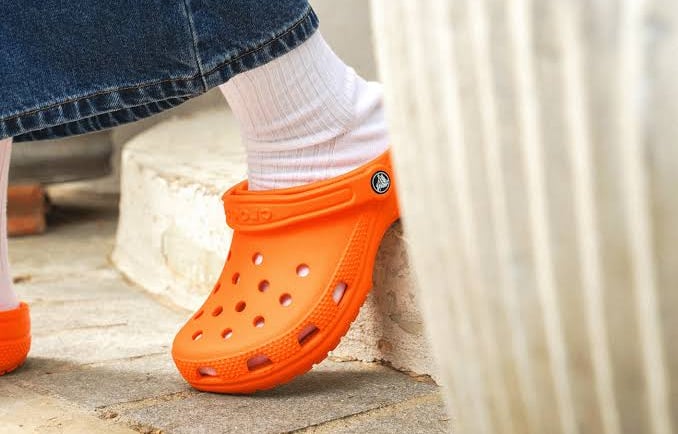👟 Welcome to Crocsy Vibe – Where Comfort Meets Global Style! 🌈
Crocs Care Myths Busted: Set the Record Straight
Don’t fall for Crocs care myths—get the real facts! Learn which cleaning tips work, what damages your shoes, and the safe way to care for Crocs. Discover if you can use washing machines, bleach, sunlight, or viral hacks, and keep your Crocs looking and feeling great for years. Say goodbye to confusion and hello to expert caring!
SHARAD RAJGURU
7/23/20257 min read


Introduction to Crocs Care Myths
Crocs have become a staple footwear choice for many, known for their comfort, versatility, and ease of use. However, alongside their popularity, a host of myths and misconceptions regarding their care and maintenance have proliferated. These myths can mislead consumers, often resulting in improper cleaning techniques and maintenance practices that can compromise the longevity and integrity of these shoes.
Proper care of Crocs is essential to ensure they remain in optimal condition for prolonged use. When cared for correctly, Crocs can withstand various weather conditions and maintain their iconic appearance over time. Understanding the truth behind common myths surrounding Crocs care is crucial, as faulty information can lead individuals to adopt practices that may inadvertently damage their footwear.
One prevalent myth is that Crocs can be cleaned using harsh chemicals or placed in the dishwasher, believing that these methods sanitize and revitalize them without any adverse effects. In fact, such practices can lead to discoloration and degradation of materials. Another widespread misconception is that all Crocs are waterproof. While they are water-resistant, extensive exposure to water over time may still affect their structure and fit.
This introduction serves as a precursor to a deeper investigation into the various myths that exist around Crocs care. In the following sections, we will debunk these misconceptions and provide readers with actionable advice on how to properly care for their beloved Crocs, preserving both their function and aesthetic appeal. By setting the record straight, we aim to foster better understanding and encourage best practices in Crocs maintenance.
Myth #1: Crocs Are Machine Washable
One of the most pervasive myths surrounding Crocs footwear is the belief that they can be safely washed in a machine. While the convenience of tossing them into the washing machine may be appealing, doing so can lead to a range of potential damages. Experts in footwear care advise against machine washing Crocs due to the risks involved, which include deformation of the shoe structure, fading of colors, and loosening of straps.
The material that Crocs are made from, a proprietary closed-cell resin known as Croslite, is designed for comfort and durability. However, when exposed to the harsh environment of a washing machine, the shoes can become misshaped. High temperatures and the agitation during the wash cycle may cause the Croslite material to warp, resulting in a loss of fit and comfort. Furthermore, colors may run or fade, diminishing the vibrant appearances that many users cherish.
Another concern relates to the straps and other components of the footwear. Machine washing can weaken or detach straps, leading to a compromised fit and usability. This is particularly concerning, as a secure fit is critical for the overall safety and comfort while wearing Crocs.
For proper cleaning, experts recommend hand-washing with mild soap and warm water instead. This method is gentler on the material and retains the shoe’s original shape and color. Using a soft cloth or sponge ensures thorough cleaning without subjecting the footwear to the potential damage that a washing machine might inflict. To keep Crocs looking their best, hand-washing is the superior option, preserving both their functionality and aesthetics while debunking the myth surrounding machine washing.
Myth #2: Bleach is a Safe Cleaner for Crocs
One of the most prevalent myths surrounding Crocs is the belief that bleach is a safe and effective cleaner for these popular footwear options. While bleach is known for its powerful cleaning capabilities, it poses significant risks when used on Crocs. The material from which Crocs are made, primarily Croslite™, is designed to withstand general wear and tear; however, it is not impervious to harsh chemicals.
Using bleach on Crocs can lead to severe damage, including compromising the structural integrity of the shoe and causing discoloration. The harsh nature of bleach can weaken the Croslite material, ultimately resulting in cracks or loss of shape. Moreover, the vibrant colors of Crocs can fade dramatically even after a single cleaning session with bleach, leaving the shoes looking worn and less appealing.
For those seeking alternative cleaning solutions, there are several safe and effective agents that can be used instead of bleach. Mild soap, such as dishwashing liquid or laundry detergent, mixed with warm water, can effectively clean dirt and stains without damaging the material. To clean your Crocs, follow these simple steps:
- Rinse your Crocs with water to remove loose dirt and debris.
- In a bowl, mix a few drops of mild soap with warm water to create a soapy solution.
- Using a soft cloth or sponge, gently scrub the surface of the Crocs to eliminate stains.
- Rinse thoroughly with clean water to remove any soap residue.
- Allow your Crocs to air dry completely, away from direct sunlight, to prevent warping.
By utilizing these safer cleaning methods, you can maintain the appearance of your Crocs without running the risk of damage caused by bleach. Adopting proper care techniques not only extends the lifespan of your footwear but also ensures they remain looking fresh and vibrant for years to come.
Myth #3: Sun-Drying Crocs is the Best Drying Method
One common misconception among Crocs owners is the belief that sun-drying is the optimal method for drying their footwear. This notion suggests that exposing Crocs to direct sunlight will evaporate moisture quickly and restore their original shape. However, this method can lead to detrimental effects on both the material and overall longevity of the shoes.
Crocs are typically made from a proprietary closed-cell resin known as Croslite, which is designed for comfort and durability. When subjected to prolonged exposure to ultraviolet (UV) rays, the Croslite material can degrade over time. This degradation manifests in several ways, including warping, loss of structural integrity, and fading of the vibrant colors that many wearers appreciate. Direct sunlight can heat the material excessively, leading to distortion and making them less comfortable to wear.
To preserve the quality of your Crocs, it is advisable to opt for safer drying methods. After washing, gently wipe away excess water using a soft cloth or towel. Then, allow the Crocs to air dry in a shaded area with good airflow. This method ensures that the shoes dry evenly without the harsh effects of direct sunlight. Additionally, prop the Crocs up at an angle to facilitate better air circulation, which aids in quickening the drying process without compromising the material.
In summary, while sun-drying Crocs may seem like an effective trick, it is essential to consider the potential damage caused by UV exposure. By employing gentle drying techniques, you can maintain the appearance, fit, and durability of your footwear, allowing them to remain a stylish and functional part of your wardrobe for years to come.
Myth #4: Miracle Cleaners Can Restore Crocs to New Condition
The belief that miracle cleaners can rejuvenate old or damaged Crocs to their original pristine state is a prevalent myth that warrants examination. Many products claim to restore footwear to a like-new appearance, yet the reality is often less favorable. Crocs, made primarily from Croslite material, exhibit wear and tear that miracle cleaners cannot fully reverse. While these products may enhance the appearance of the shoes to a certain extent, they are not a panacea for all cosmetic flaws.
It is essential to recognize that the effectiveness of these cleaners is limited. They may address surface stains or dirt, but they cannot repair fading color, cracking, or structural integrity loss that shoes can suffer over time. Expecting a miracle cleaner to breathe new life into worn-out Crocs can lead to disappointment. Instead, investing time in proper care and maintenance is critical for prolonging the lifespan of these comfortable shoes.
Practical tips for maintaining Crocs include regular cleaning with mild soap and water, which can significantly reduce the buildup of grime. Additionally, keeping Crocs out of direct sunlight when not in use helps prevent discoloration, while storing them in a cool, dry place limits moisture exposure, a factor that can lead to unwelcome odors or deformation. It is beneficial to avoid harsh chemicals and abrasive scrubbing pads, as these can damage the outer layer of the footwear.
Ultimately, while miracle cleaners may provide temporary improvements, realistic expectations regarding Crocs restoration are crucial. By prioritizing maintenance and understanding the limitations of such products, you can ensure that your beloved footwear remains in good condition for as long as possible.
Myth #5: Regular Habits Can Ruin Crocs
The belief that everyday habits can ruin Crocs is widespread among consumers, leading to a plethora of misconceptions about the care and maintenance of these popular footwear options. One common assertion is that wearing Crocs in water can damage them. Contrary to this myth, Crocs are designed to be water-resistant, making them suitable for environments such as pools or beaches. Their closed-cell resin construction prevents water absorption, which means that they dry quickly and are less prone to damage from moisture.
Another belief involves the types of surfaces on which Crocs can be worn. Some individuals argue that walking on abrasive surfaces can lead to premature wear and tear. While it is true that certain terrains can affect the outsole's condition, Crocs are equipped with durable traction soles that are built to withstand various surfaces. Thus, wearing them on multiple terrains—including gravel and concrete—does not necessarily compromise their longevity, provided that proper care is taken after exposure to such environments.
Temperature variations also contribute to concerns about Crocs. Some users fear that extreme heat or cold can lead to deformation or cracking of the material. However, Crocs perform well within a wide range of temperatures. It is advised to avoid prolonged exposure to extreme heat sources, such as direct sunlight for extended periods or leaving them in a hot car, as this may warp the shoe’s shape. Conversely, exposure to very low temperatures is generally not damaging, but caution should be exercised if prevails any moisture, as freezing conditions can lead to brittleness if the shoes are not dried properly.
By understanding these aspects of Crocs care, users can confidently incorporate them into their daily routines without worrying that their habits will ruin their favorite footwear. Ultimately, awareness and proper usage are essential to maintain their durability and functionality.
Conclusion
In conclusion, properly caring for your Crocs is essential to maintain their longevity and appearance. Throughout this article, we have debunked several common myths associated with Crocs care. Many individuals mistakenly believe that washing them in a machine or exposing them to high heat will keep them clean and fresh. However, these methods can actually damage the material and diminish their quality. Instead, adopting gentle cleaning practices such as using mild soap and warm water can ensure that your Crocs remain in good condition.
Additionally, it is important to understand that Crocs are designed for comfort and versatility. Regularly inspecting your footwear for signs of wear and tear and storing them correctly will help prolong their life. This includes keeping them out of direct sunlight for extended periods to prevent fading and distortion. By following these proper care methods, you can enhance the durability of your Crocs and ensure they continue providing comfort during everyday activities.
We encourage our readers to share their experiences and tips surrounding Crocs care. Engaging in this conversation can provide valuable insights into the best practices for maintaining these beloved footwear options. Please feel free to leave comments, pose questions, or share your own tips on Crocs maintenance below. Additionally, for further reading and resources on how to care for your Crocs, make sure to explore the links we have provided. By adhering to accurate care methods, you not only extend the life of your footwear but also promote sustainability in footwear choices.

Get in touch
Address
3721 Single Street
Quincy, MA 02169
Contacts
123-456-7890
info@email.com
